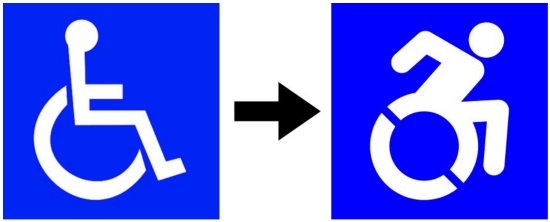A fundraiser for the Forward Movement April 23 supports a more dynamic accessibility icon
BY MICHELLE DA SILVA / APRIL 19, 2017 1:58 PM
 Accessibility advocates in Toronto are putting pressure on the Ontario government to adopt a new, more dynamic accessibility icon. Since last year, the Forward Movement has been plastering the city with stickers of the preferred barriers-free symbol. They’ve also collected signatures for a petition showing community support.
Accessibility advocates in Toronto are putting pressure on the Ontario government to adopt a new, more dynamic accessibility icon. Since last year, the Forward Movement has been plastering the city with stickers of the preferred barriers-free symbol. They’ve also collected signatures for a petition showing community support.
On April 23, they’re organizing a community event and fundraiser to help attract attention of MPPs. The event is free, fully accessible and sales of food, beverages and raffle tickets will help raise money for stickers bearing the preferred symbol which the group plans to distribute free to local businesses.
Jonathan Silver explains: “If businesses get those stickers up, we can speed up informal adoption, which will lead to speeding up formal adoption.”
Silver, a design activist, started the Forward Movement with Dylan Itzikowitz, a graduate student who’s been in and out of a wheelchair after being struck by a drunk driver last year. The two partnered after Silver heard about a new accessibility symbol on the podcast 99% Invisible.
“Afterwards, everywhere I looked, I saw the current symbol and it didn’t make sense,” Silver says. “It seemed out of date and not up to speed with all the progress being made for disability rights,” including AccessTO, a non-profit website providing in-depth reviews of the accessibility of places in Toronto, and AccessNow, a smartphone app that uses crowdsourcing to determine the accessibility status of locations on an interactive map.
Toronto’s StopGap Foundation, which has been building ramps for single-step storefronts since 2011, has also been a driving force in making the city accessible for everyone. The province has lofty goals of being completely barrier-free by 2025.
The current accessibility sign showing a person in a wheelchair was developed in 1969. A few years ago, the Massachusetts-based Accessible Icon Project came up with a new sign with a slightly modified symbol. Its background is still blue, but the person in the wheelchair is leaning forward with their arms up behind them, appearing to be on the move rather than stationary.
“The current image doesn’t focus enough on ability. It portrays a passive picture of the person in the wheelchair,” Silver says.
He adds that adopting the sign change would not only change public perceptions about disabilities, but recognize the understanding people in wheelchairs have about themselves.
“You never know when you or someone you know is going to need barrier-free access,” Silver says. “It’s a question of democracy, to be engaged in issues that don’t affect you now but may affect you down the line.”
